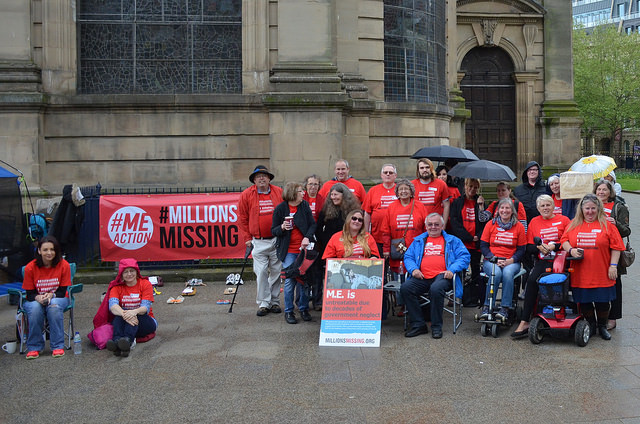
Countless numbers of people suffer with illness, some acutely, some chronically, some with mild, non-debilitating symptoms and some with devastating symptoms that severely impact their ability to lead normal lives. Often we aren’t aware of it because they don’t appear to be sick — they have “invisible” illnesses.
At the same time, many suffering with invisible illness are “missing,” because they are incapacitated to the point of being home bound or bedridden. They may be able to engage in life to a certain extent, but the quality of their lives is significantly altered by not being able to participate fully. For instance, taking care of basic necessities may be possible, but then there is no energy left for things that bring joy, connection or build community.
Because these diseases are poorly understood and difficult to diagnose, the people stricken with them are not taken seriously by doctors or the scientific research institutions funded to study causes and treatments for disease. So there are millions waiting desperately in the wings for a breakthrough in the treatment for their conditions and alleviation of their distress. Such is the case for anyone suffering with a CIND.
 CIND stands for chronic immunological and neurological diseases. Diseases that fall under the CIND umbrella are Myalgic Encephalomyelitis (ME is also known as Chronic Fatigue Syndrome), Fibromyalgia (FM), Gulf War Syndrome (GWS) and Multiple Chemical Sensitivity (MCS). Living with ME, FM, GWS or MCS is difficult to imagine if you don’t suffer yourself or are not close to someone who is afflicted. Beyond the difficult challenge of living with intense pain and discomfort, those living with a CIND have the added layer of dealing with despairing isolation because they are often either homebound or physically immobile. Indeed, many must stop working and attempt to eke out an existence on disability benefits, which often can’t cover medical care costs, let alone basic necessities, like housing, utilities and food. Think about the anxiety that must produce.
CIND stands for chronic immunological and neurological diseases. Diseases that fall under the CIND umbrella are Myalgic Encephalomyelitis (ME is also known as Chronic Fatigue Syndrome), Fibromyalgia (FM), Gulf War Syndrome (GWS) and Multiple Chemical Sensitivity (MCS). Living with ME, FM, GWS or MCS is difficult to imagine if you don’t suffer yourself or are not close to someone who is afflicted. Beyond the difficult challenge of living with intense pain and discomfort, those living with a CIND have the added layer of dealing with despairing isolation because they are often either homebound or physically immobile. Indeed, many must stop working and attempt to eke out an existence on disability benefits, which often can’t cover medical care costs, let alone basic necessities, like housing, utilities and food. Think about the anxiety that must produce.
May 12 has been designated International Awareness Day for CIND, established to raise awareness and educate the public, medical professionals and research institutions about this particular category of complex and misunderstood disorders. May 12 is also Millions Missing Action Day, when people around the world will be demonstrating to demand action for those living with ME.
 But to get a real sense of what it is like to live with a CIND, I recommend watching “Unrest.” This award winning documentary was produced and directed by Jennifer Brea who herself has ME. Prior to falling ill, Brea was a newly married Harvard PhD student with a promising career on her horizon. Her film tells the difficult, heart wrenching tale of her journey from the freedom of being healthy to becoming devastatingly sick, then attempting to convince her doctors to take her seriously while being told that her illness was “all in her head.” Utterly frustrated and despondent over her inability to get support from the medical community, Brea took what little energy she had available and reached out through the internet, from her bed, to connect with others around the world who were similarly impacted. With the help of their stories in Unrest and activist events taking place around the globe, those suffering with CIND are gaining traction for their cause. The medical and scientific research communities are beginning to give earnest attention to these disorders. With hope, medical breakthroughs will soon lead to treatments that will repair the health of millions debilitated by CIND.
But to get a real sense of what it is like to live with a CIND, I recommend watching “Unrest.” This award winning documentary was produced and directed by Jennifer Brea who herself has ME. Prior to falling ill, Brea was a newly married Harvard PhD student with a promising career on her horizon. Her film tells the difficult, heart wrenching tale of her journey from the freedom of being healthy to becoming devastatingly sick, then attempting to convince her doctors to take her seriously while being told that her illness was “all in her head.” Utterly frustrated and despondent over her inability to get support from the medical community, Brea took what little energy she had available and reached out through the internet, from her bed, to connect with others around the world who were similarly impacted. With the help of their stories in Unrest and activist events taking place around the globe, those suffering with CIND are gaining traction for their cause. The medical and scientific research communities are beginning to give earnest attention to these disorders. With hope, medical breakthroughs will soon lead to treatments that will repair the health of millions debilitated by CIND.


